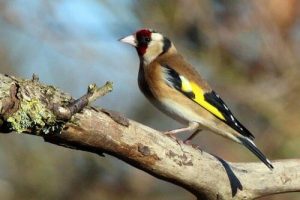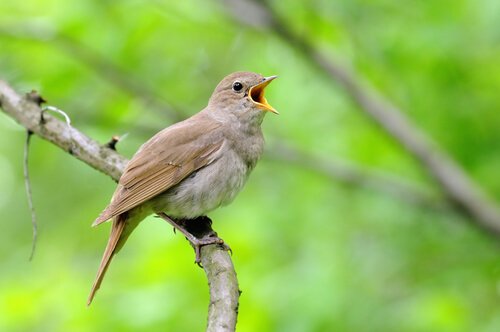The 5 Prettiest Songbirds

There are a few things that are so beautiful like waking up to a beautiful songbird on your bedroom window sill. Read this article to find out what are the prettiest songbirds. If you want to enjoy them yourself, there is no need to keep them trapped in a cage… just plant more trees!
What are the prettiest songbirds?
Maybe you live in a city where it’s not possible to plant a tree in the street, but that’s no reason to have a bird cooped up in a cage just so they can sing for you. Going out for a walk in the countryside or in a park is a good way to enjoy the music that comes from the following birds.
1. Goldfinch
Its scientific name is Carduelis (look at the photo above), and it lives mainly in Eurasia, North America, including the North and South of the Mediterranean.
They are very small, have beautiful and colorful plumage, and their songs are some of the most beautiful in the entire animal kingdom. They can mix low and high-pitched sounds and sing while flying! They’re most active during the spring and summer and they can also compose fascinating coos.
2. Nightingale
This is another small bird with great musical talent that couldn’t be left out of this list. The nightingale is a passerine, migratory bird (they fly to Africa during the winter), and it’s an insectivore which lives in the forests of Europe and Asia. They make their nests close to the ground in dense bushes.

Males are famous for singing loudly by burbling and whistling, among other sounds. Although they’re more active during the day, some also put on “artistic performances” during the night. For many people, these birds announce the arrival of spring.
The nightingale measures about 16 cm, has a tawny brown color on its wings and tail, and it has a light brown breast. There are no notable differences between the sexes.
3. Blackbird
There are different species of blackbirds and all of them could be included in this prettiest songbird list. The Turdus Merula or the common blackbird, live all over Europe, North Africa, the Arabian Peninsula, and West Asia.

Males are covered in black feathers and the only things that stand out are their beak and legs, which are yellow. The females are brown and their beak and legs have a strong orange color.
They eat fruits, berries, insects, worms, and seeds. They mainly find food on the ground where they run and jump around. Males begin to sing as of the age of one year, between January and July, in order to mark their territory.
The sound of their music is low-pitched, melodic and flute-like. Their melodic variations and improvisations have them stand out from other songbirds.
4. Finch
this is another bird that sings beautifully and shares a lot of its territory with the blackbird. They like forested areas, but you can also find them in gardens and on farms. They nest in trees and decorate their homes with lichens and moss.

These birds don’t migrate during the winter, although they do seek shelter in warmer places nearby. They have an insect-based diet when they’re younger and a seed-based diet when during adulthood.
Their song is very powerful and well-known. Males know three types of different songs and can even have dialects depending on the region.
5. Robin
There are two species of robins, one in Europe and the other in the Americas, and both could be included in this list. The European is very social, lives in forests, and lets off a sort of alarm, but also a musical and melodic burbling similar to the nightingale.

They measure about 20 cm and males and females have similar plumage. They have an orange face and breast, the sides of their neck and torso have a greyish-blue color, they have a white belly, and their back and legs are brown. When born they are orange and brown.
They mainly eat insects, spiders, and worms. They mainly come out during the day so they’re used to humans. They lay their eggs in a nest made from twigs or mossy stones, grass, and leaves. The females can lay between five to six eggs three times a year.
There are a few things that are so beautiful like waking up to a beautiful songbird on your bedroom window sill. Read this article to find out what are the prettiest songbirds. If you want to enjoy them yourself, there is no need to keep them trapped in a cage… just plant more trees!
What are the prettiest songbirds?
Maybe you live in a city where it’s not possible to plant a tree in the street, but that’s no reason to have a bird cooped up in a cage just so they can sing for you. Going out for a walk in the countryside or in a park is a good way to enjoy the music that comes from the following birds.
1. Goldfinch
Its scientific name is Carduelis (look at the photo above), and it lives mainly in Eurasia, North America, including the North and South of the Mediterranean.
They are very small, have beautiful and colorful plumage, and their songs are some of the most beautiful in the entire animal kingdom. They can mix low and high-pitched sounds and sing while flying! They’re most active during the spring and summer and they can also compose fascinating coos.
2. Nightingale
This is another small bird with great musical talent that couldn’t be left out of this list. The nightingale is a passerine, migratory bird (they fly to Africa during the winter), and it’s an insectivore which lives in the forests of Europe and Asia. They make their nests close to the ground in dense bushes.

Males are famous for singing loudly by burbling and whistling, among other sounds. Although they’re more active during the day, some also put on “artistic performances” during the night. For many people, these birds announce the arrival of spring.
The nightingale measures about 16 cm, has a tawny brown color on its wings and tail, and it has a light brown breast. There are no notable differences between the sexes.
3. Blackbird
There are different species of blackbirds and all of them could be included in this prettiest songbird list. The Turdus Merula or the common blackbird, live all over Europe, North Africa, the Arabian Peninsula, and West Asia.

Males are covered in black feathers and the only things that stand out are their beak and legs, which are yellow. The females are brown and their beak and legs have a strong orange color.
They eat fruits, berries, insects, worms, and seeds. They mainly find food on the ground where they run and jump around. Males begin to sing as of the age of one year, between January and July, in order to mark their territory.
The sound of their music is low-pitched, melodic and flute-like. Their melodic variations and improvisations have them stand out from other songbirds.
4. Finch
this is another bird that sings beautifully and shares a lot of its territory with the blackbird. They like forested areas, but you can also find them in gardens and on farms. They nest in trees and decorate their homes with lichens and moss.

These birds don’t migrate during the winter, although they do seek shelter in warmer places nearby. They have an insect-based diet when they’re younger and a seed-based diet when during adulthood.
Their song is very powerful and well-known. Males know three types of different songs and can even have dialects depending on the region.
5. Robin
There are two species of robins, one in Europe and the other in the Americas, and both could be included in this list. The European is very social, lives in forests, and lets off a sort of alarm, but also a musical and melodic burbling similar to the nightingale.

They measure about 20 cm and males and females have similar plumage. They have an orange face and breast, the sides of their neck and torso have a greyish-blue color, they have a white belly, and their back and legs are brown. When born they are orange and brown.
They mainly eat insects, spiders, and worms. They mainly come out during the day so they’re used to humans. They lay their eggs in a nest made from twigs or mossy stones, grass, and leaves. The females can lay between five to six eggs three times a year.
This text is provided for informational purposes only and does not replace consultation with a professional. If in doubt, consult your specialist.








